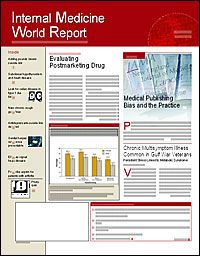Publication
Article
Internal Medicine World Report
Celiac Disease Underdiagnosed in Patients with Type 1 Diabetes
Author(s):
Primary care physicians should consider the possibility of celiac disease in their patients with type 1 diabetes, as the ?disorder is not uncommon in this population and is often asymptomatic regardless of age, according to a study ?published in the Mayo Clinic Pro?ceed?ings (2005;80: 1429-1434).
This study, conducted by lead investigator Farid H. Mahmud, MD, who at the time was from the Mayo Clinic College of Medicine, Rochester, Minn, and is now at the Children's Hospital of Western Ontario, London Health Sciences Center, London, Ontario, and colleagues at the Mayo Clinic, looked at all residents of Olmsted County, Minn, with type 1 diabetes using the Rochester Epidemiology Project, a medical records linkage system.
A total of 392 patients with type 1 diabetes were identified on January 1, 2001, 158 of whom were tested for celiac disease by serologic assay. Of these patients, 11 had biopsy-proven celiac disease; 4 were identified on the basis of clinical symptoms and had been tested for celiac disease by their physicians; and 7 were identified only by serologic screening. The majority of those who tested positive for celiac disease were asymptomatic at the time of diagnosis and expressed an at-risk celiac disease haplotype with at least 1 HLA DQ2 or DQ8 haplotype, but not both.
The investigators noted that the common signs and symptoms of celiac disease, namely diarrhea and weight loss, have been observed less often in recent years in patients diagnosed with the disease. And although the association between type 1 diabetes and celiac disease has been recognized, routine screen?ing for celiac disease in patients with diabetes is "neither a universal nor accepted practice in North America, unlike in other jurisdictions," they wrote.
In keeping with recent clinical data, the majority of the participants who were diagnosed with celiac disease did not exhibit the typical clinical symptoms of the disease. One 14-year-old patient had lactose intolerance, and 1 adult patient had diarrhea. In addition, 1 patient who continued to consume gluten developed dermatitis herpetiformis.
These results indicate that celiac disease is underdiagnosed in patients with type 1 diabetes and, hence, underreported. The investigators extrapolated that among the wider diabetic population, "upward of 66,000 diabetics also may have celiac disease, based on an estimated 942,000 patients with type 1 diabetes living in the United States."
Nationwide screening for celiac disease among patients with type 1 diabetes is thus warranted and could substantially increase the overall prevalence of diagnosed celiac disease in this population, they concluded.





